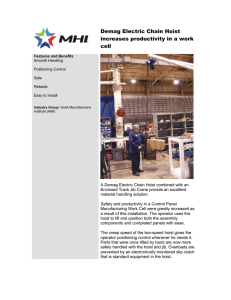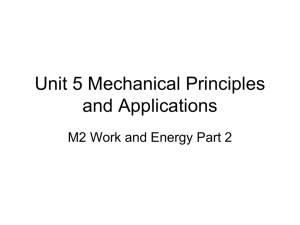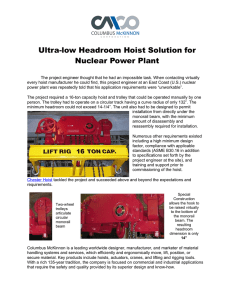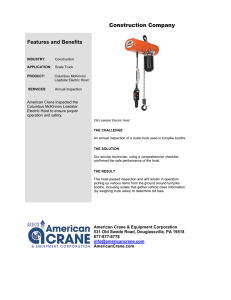DISCLAIMER - Harrington Hoists
advertisement
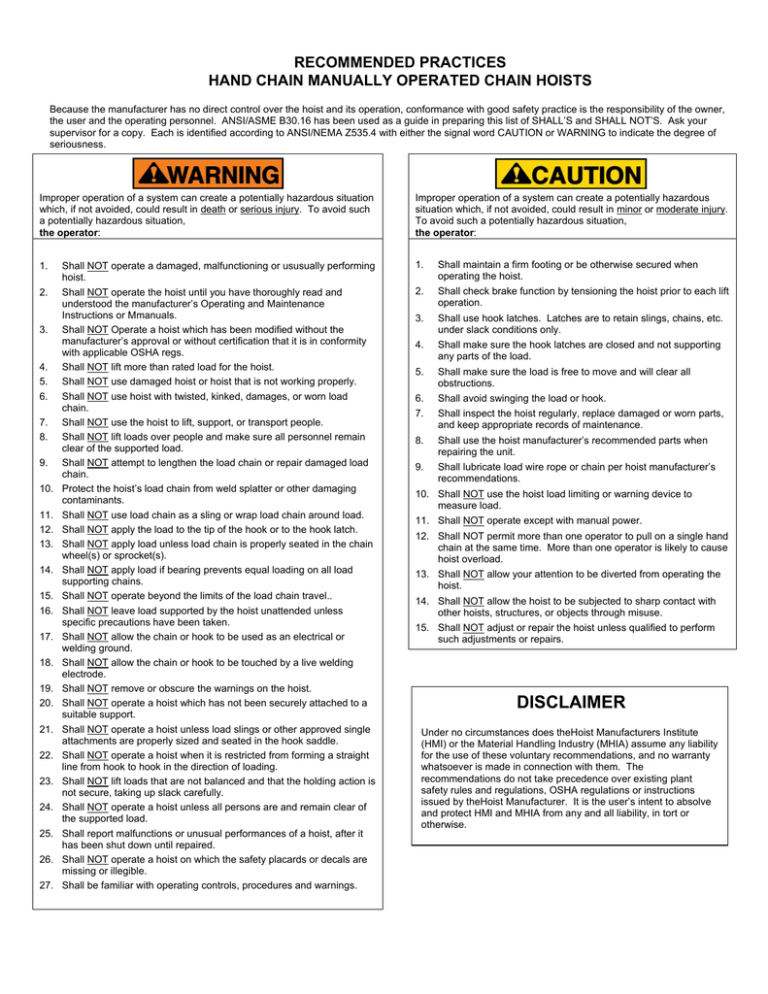
RECOMMENDED PRACTICES HAND CHAIN MANUALLY OPERATED CHAIN HOISTS Because the manufacturer has no direct control over the hoist and its operation, conformance with good safety practice is the responsibility of the owner, the user and the operating personnel. ANSI/ASME B30.16 has been used as a guide in preparing this list of SHALL’S and SHALL NOT’S. Ask your supervisor for a copy. Each is identified according to ANSI/NEMA Z535.4 with either the signal word CAUTION or WARNING to indicate the degree of seriousness. Improper operation of a system can create a potentially hazardous situation which, if not avoided, could result in death or serious injury. To avoid such a potentially hazardous situation, the operator: Improper operation of a system can create a potentially hazardous situation which, if not avoided, could result in minor or moderate injury. To avoid such a potentially hazardous situation, the operator: 1. 1. Shall maintain a firm footing or be otherwise secured when operating the hoist. 2. Shall check brake function by tensioning the hoist prior to each lift operation. 3. Shall use hook latches. Latches are to retain slings, chains, etc. under slack conditions only. 4. Shall make sure the hook latches are closed and not supporting any parts of the load. 5. Shall make sure the load is free to move and will clear all obstructions. 6. Shall avoid swinging the load or hook. 7. Shall inspect the hoist regularly, replace damaged or worn parts, and keep appropriate records of maintenance. 8. Shall use the hoist manufacturer’s recommended parts when repairing the unit. 9. Shall lubricate load wire rope or chain per hoist manufacturer’s recommendations. 2. 3. 4. 5. 6. 7. 8. 9. 10. 11. 12. 13. 14. 15. 16. 17. 18. 19. 20. 21. 22. 23. 24. 25. 26. 27. Shall NOT operate a damaged, malfunctioning or ususually performing hoist. Shall NOT operate the hoist until you have thoroughly read and understood the manufacturer’s Operating and Maintenance Instructions or Mmanuals. Shall NOT Operate a hoist which has been modified without the manufacturer’s approval or without certification that it is in conformity with applicable OSHA regs. Shall NOT lift more than rated load for the hoist. Shall NOT use damaged hoist or hoist that is not working properly. Shall NOT use hoist with twisted, kinked, damages, or worn load chain. Shall NOT use the hoist to lift, support, or transport people. Shall NOT lift loads over people and make sure all personnel remain clear of the supported load. Shall NOT attempt to lengthen the load chain or repair damaged load chain. Protect the hoist’s load chain from weld splatter or other damaging contaminants. Shall NOT use load chain as a sling or wrap load chain around load. Shall NOT apply the load to the tip of the hook or to the hook latch. Shall NOT apply load unless load chain is properly seated in the chain wheel(s) or sprocket(s). Shall NOT apply load if bearing prevents equal loading on all load supporting chains. Shall NOT operate beyond the limits of the load chain travel.. Shall NOT leave load supported by the hoist unattended unless specific precautions have been taken. Shall NOT allow the chain or hook to be used as an electrical or welding ground. Shall NOT allow the chain or hook to be touched by a live welding electrode. Shall NOT remove or obscure the warnings on the hoist. Shall NOT operate a hoist which has not been securely attached to a suitable support. Shall NOT operate a hoist unless load slings or other approved single attachments are properly sized and seated in the hook saddle. Shall NOT operate a hoist when it is restricted from forming a straight line from hook to hook in the direction of loading. Shall NOT lift loads that are not balanced and that the holding action is not secure, taking up slack carefully. Shall NOT operate a hoist unless all persons are and remain clear of the supported load. Shall report malfunctions or unusual performances of a hoist, after it has been shut down until repaired. Shall NOT operate a hoist on which the safety placards or decals are missing or illegible. Shall be familiar with operating controls, procedures and warnings. 10. Shall NOT use the hoist load limiting or warning device to measure load. 11. Shall NOT operate except with manual power. 12. Shall NOT permit more than one operator to pull on a single hand chain at the same time. More than one operator is likely to cause hoist overload. 13. Shall NOT allow your attention to be diverted from operating the hoist. 14. Shall NOT allow the hoist to be subjected to sharp contact with other hoists, structures, or objects through misuse. 15. Shall NOT adjust or repair the hoist unless qualified to perform such adjustments or repairs. DISCLAIMER Under no circumstances does theHoist Manufacturers Institute (HMI) or the Material Handling Industry (MHIA) assume any liability for the use of these voluntary recommendations, and no warranty whatsoever is made in connection with them. The recommendations do not take precedence over existing plant safety rules and regulations, OSHA regulations or instructions issued by theHoist Manufacturer. It is the user’s intent to absolve and protect HMI and MHIA from any and all liability, in tort or otherwise.
